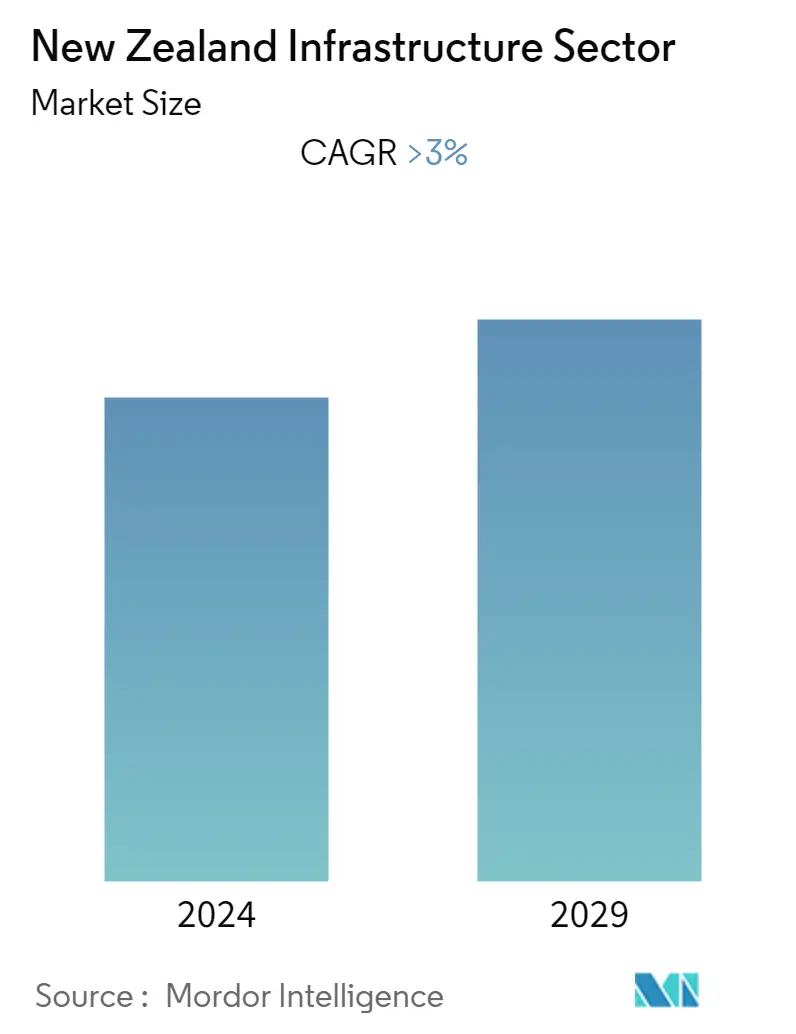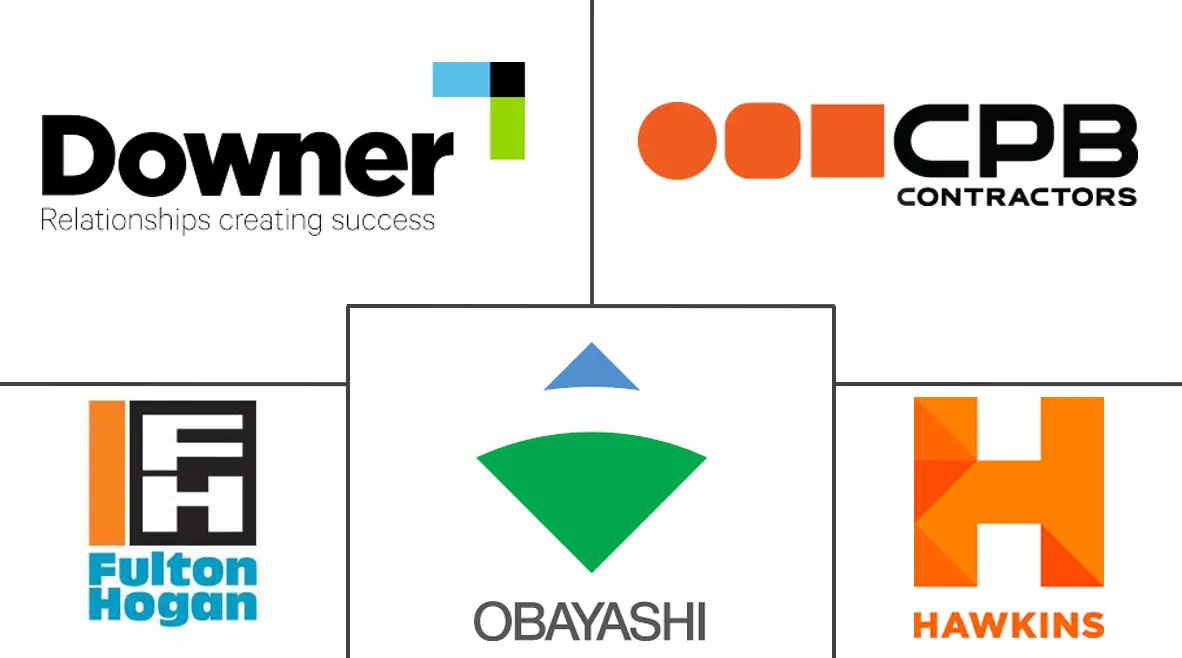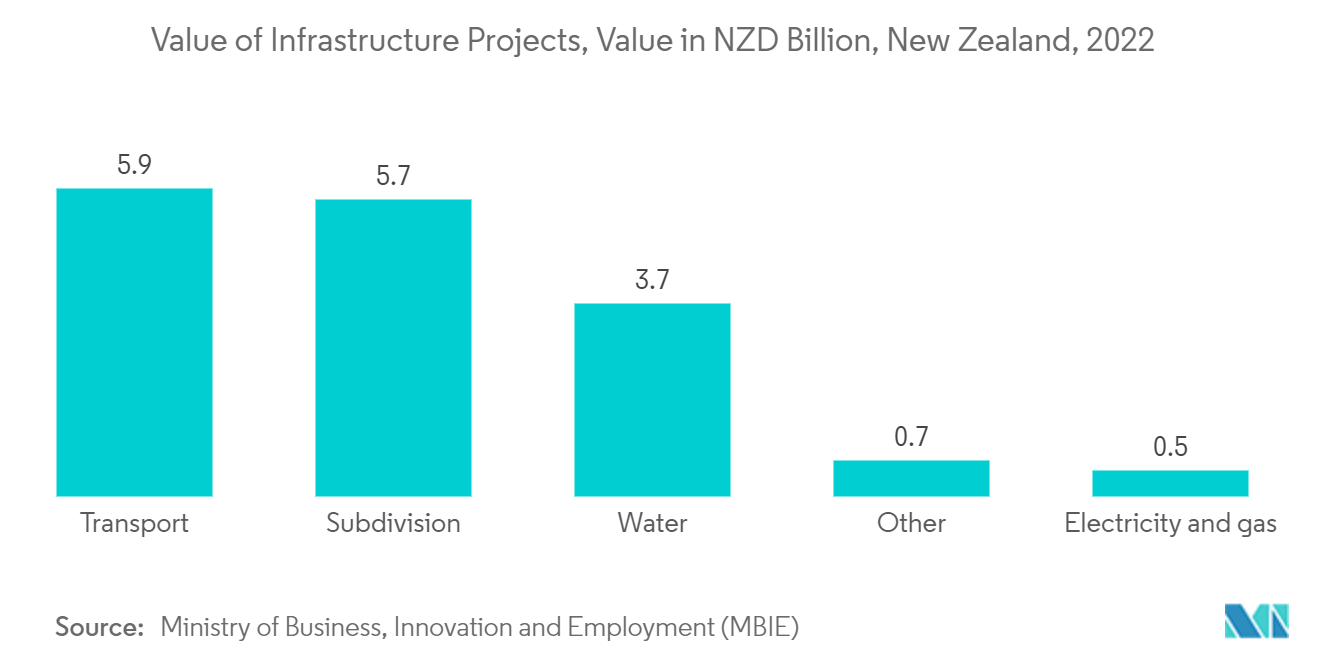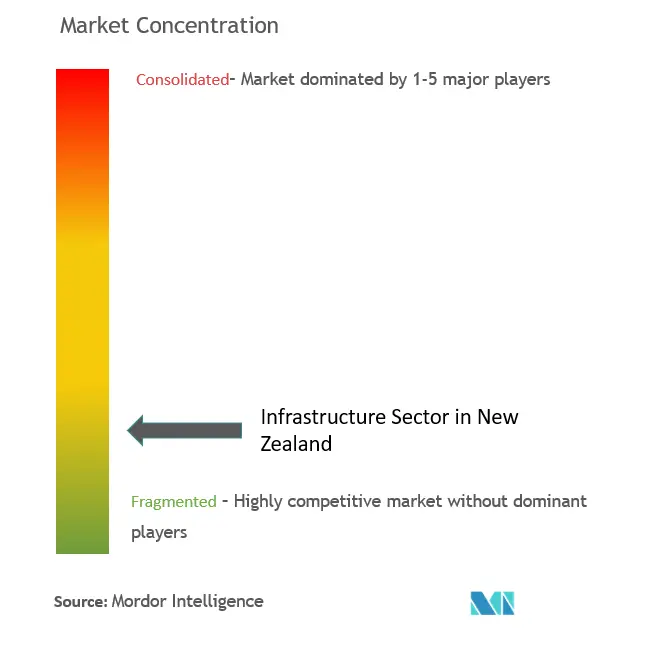New Zealand Infrastructure Sector Market Size

| Study Period | 2020 - 2029 |
| Base Year For Estimation | 2023 |
| Forecast Data Period | 2024 - 2029 |
| Historical Data Period | 2020 - 2022 |
| CAGR | 3.00 % |
| Market Concentration | Low |
Major Players
*Disclaimer: Major Players sorted in no particular order |
New Zealand Infrastructure Sector Market Analysis
The infrastructure sector in New Zealand is expected to register a CAGR of over 3% during the forecast period (2023-2028).
- The COVID-19 pandemic impacted the infrastructure industry in the country. The construction activity in the infrastructure sector declined in Q2 2020. In addition, in Q2 2022, vertical infrastructure, which was majorly driven by private investment, experienced a 26% decline in activity compared to the same period in 2019. The infrastructure sector is currently recovering from the pandemic.
- Transportation is one of the major sub-sectors of the country's infrastructure sector. The sector is witnessing significant growth, majorly driven by increasing investments. For instance, in September 2021, more than USD 24 billion in investment was planned for New Zealand's land transport system for the next three years. The total fund includes USD 15.6 billion from National Land Transport Fund (NLTF) and USD 4.6 billion from the local government. In addition, the government invested USD 3.8 billion in additional Crown funding to deliver specific programs through the NLTP.
- Auckland is witnessing lucrative growth in infrastructure projects and creating huge opportunities for private capital, consultants, and developers. The city is registering significant investments in the transport infrastructure sector. In addition, in May 2022, the Auckland Light Rail (ALR) provided opportunities for professional services and consultancy services to procure the project. The project's estimated cost is NZD 14.6 billion (USD 9.3 billion), currently considered New Zealand's largest and most complex infrastructure project. Thus, the increasing investments and sustainable projects will likely drive the infrastructure sector in the country.
New Zealand Infrastructure Sector Market Trends
This section covers the major market trends shaping the New Zealand Infrastructure Sector Market according to our research experts:
Increasing Demand for Transport Infrastructure Driving the Market
In December 2022, New Zealand's Ministry of Transport announced nearly USD 350 million worth of transport infrastructure projects across the country. The package includes 397 new or upgraded bus stops to improve people's access to public transport, the construction of 242 kilometers of cycleways to encourage more cycling, improving 119 schools, and the construction of 11 new bus priority lanes. Auckland Transport has been allocated USD 75 million from this package, as Auckland Transport and the Ministry play a crucial role in providing a low-emission, climate-resilient future for the city.
In August 2022, a new transportation infrastructure plan was proposed for New Zealand's largest city. The plan aimed to reduce city traffic, and a budget of more than USD 129 million was planned to improve Auckland's traffic flow. In addition, the USD 1.29 billion budget is aimed at improving sustainable transport in the city, with a plan to install EV charging technology in homes, expand the city's cycling facilities, and introduce zero-emissions buses by 2030. The main aim of this project is to cut the private car utilization rate by more than 50%, encourage public transport usage, and cycle commuting from its present low of 1% to around 13%.
Meanwhile, in September 2022, the country's government invested in local infrastructure to support decarbonization. More than USD 30 million was planned to invest in the Streets for the People program. As per the Ministry of Business, Innovation, and Employment (MBIE), in 2022, transportation infrastructure projects dominated the infrastructure work by more than NZD 5.9 billion (USD 3.7 billion). Thus, the increasing demand for transportation infrastructure is driving the market.

Non-residential Buildings Witnessing Significant Growth
In 2022, the private sector was the largest initiator of non-residential buildings, contributing more than 66% of the non-residential buildings sector value, whereas central and local governments made up 22% and 13%, respectively. Post lockdowns, non-residential buildings such as shop refits and new storage and logistics facilities witnessed significant growth driven by increasing online sales. In 2022, industry experts saw growth in tourist facility projects to accommodate the visitors of the country.
In 2022, the building and construction sector was New Zealand's fourth-largest industry in terms of GDP contribution, and the industry was responsible for delivering much-needed housing, offices, and commercial buildings. The country's government is currently focusing on developing sustainable building standards for new government-owned non-residential buildings to support the Carbon Neutral Government Programme (CNGP). This program ensures government-owned buildings are designed to reduce embodied and operational carbon and waste, such as construction and demolition waste. These sustainability measures support future commercial projects in the country.
Meanwhile, in 2022, commercial buildings dominated non-residential building work by contributing more than 43% of the total number of projects and approximately 44% of the total value. In addition, planned visitor accommodation projects were delayed back in 2020. Currently, these projects are in the progress stage. Education projects also witnessed significant growth, contributing more than 23% of the total number of non-residential building projects.

New Zealand Infrastructure Sector Industry Overview
The report covers the major players operating in the infrastructure sector in New Zealand. The market is fragmented and expected to grow during the forecast period due to upcoming projects and investments. Some of the major players in the market include Obayashi Corporation Limited, Fulton Hogan Limited, Hawkins Limited, and Downer Group.
New Zealand Infrastructure Sector Market Leaders
-
Obayashi Corporation Limited
-
Fulton Hogan Limited
-
Hawkins Limited
-
Downer Group
-
Cpb Contractors Pty Limited
*Disclaimer: Major Players sorted in no particular order

New Zealand Infrastructure Sector Market News
November 2022: Hawkins, a construction company, was awarded a contract to build the Court Theatre's new central city home by Christchurch City Council. The Council funded more than USD 46 million toward the development of the Performing Arts Precinct, which includes the construction of The Court Theatre, the public realm, and landscaping.
November 2022: Fulton Hogan, a construction company, completed the first of four-floor slab pours for the new Redoubt Reservoir project. The construction work in the reservoir includes 650 ton of steel reinforcing, and the project is expected to be completed in March 2024.
New Zealand Infrastructure Sector Market Report - Table of Contents
1. INTRODUCTION
- 1.1 Study Deliverables
- 1.2 Study Assumptions
- 1.3 Scope of the Study
2. RESEARCH METHODOLOGY
3. EXECUTIVE SUMMARY
4. MARKET INSIGHTS AND DYNAMICS
- 4.1 Current Economic and Construction Market Scenario
- 4.2 Impact of Government Regulations and Initiatives on the Industry
- 4.3 Supply Chain/Value Chain Analysis
- 4.4 Insights on Technology Snapshot and Digital Trends
- 4.5 Insights on Modernization of the Transportation Infrastructure Sector
- 4.6 Insights on Major Infrastructure Development Projects
- 4.7 Insights on Ongoing and Upcoming Infrastructure Projects
-
4.8 Market Dynamics
- 4.8.1 Market Drivers
- 4.8.2 Market Restraints
- 4.8.3 Market Opportunities
- 4.9 Porter's Five Forces Analysis
- 4.10 Impact of COVID-19 on the Market
5. MARKET SEGMENTATION
-
5.1 By Infrastructure segment
- 5.1.1 Social Infrastructure
- 5.1.1.1 Schools
- 5.1.1.2 Hospitals
- 5.1.1.3 Defence
- 5.1.1.4 Other Social Infrastructures
- 5.1.2 Transportation Infrastructure
- 5.1.2.1 Railways
- 5.1.2.2 Roadways
- 5.1.2.3 Airports
- 5.1.2.4 Waterways
- 5.1.3 Extraction Infrastructure
- 5.1.3.1 Power Generation
- 5.1.3.2 Electricity Transmission and Distribution
- 5.1.3.3 Water
- 5.1.3.4 Gas
- 5.1.3.5 Telecoms
- 5.1.4 Manufacturing Infrastructure
- 5.1.4.1 Metal and Ore Production
- 5.1.4.2 Petroleum Refining
- 5.1.4.3 Chemical Manufacturing
- 5.1.4.4 Industrial Parks and Clusters
- 5.1.4.5 Other Manufacturing Infrastructures
-
5.2 By Key Cities
- 5.2.1 Wellington
- 5.2.2 Auckland
- 5.2.3 Hamilton
6. COMPETITIVE LANDSCAPE
- 6.1 Competition Overview (Overview and Market Share Analysis)
-
6.2 Company Profiles
- 6.2.1 Obayashi Corporation Limited
- 6.2.2 Fulton Hogan Limited
- 6.2.3 Hawkins Limited
- 6.2.4 Downer Group
- 6.2.5 Cpb Contractors Pty Limited
- 6.2.6 City Care Limited
- 6.2.7 Kiwi Property Group Limited
- 6.2.8 Naylor Love Enterprises Limited
- 6.2.9 Electrix Limited
- 6.2.10 Visionstream Pty Limited
- *List Not Exhaustive
7. MARKET OPPORTUNITIES AND FUTURE TRENDS
8. APPENDIX
** Subject To AvailablityNew Zealand Infrastructure Sector Industry Segmentation
Infrastructure is the backbone of domestic and international commerce and industrial and agricultural production. It is the fundamental organizational and physical framework necessary to operate a firm successfully. Basic infrastructure in an organization or a nation comprises communication and transportation, sewage, water, a health and education system, safe drinking water, and a monetary system. The report includes a complete background analysis of the New Zealand infrastructure sector, including the assessment of the economy and contribution of sectors in the economy, market overview, market size estimation for key segments, and emerging trends in the market segments, market dynamics, and geographical trends, and COVID-19 impact.
The infrastructure sector in New Zealand is segmented by type (social infrastructure (schools, hospitals, defense, and other infrastructure), transportation infrastructure (railways, roadways, airports, ports, and waterways), extraction infrastructure (oil and gas, other extraction (minerals, metals, and coal), utilities infrastructure (power generation, electricity transmission and distribution, water, gas, and telecoms), manufacturing infrastructure (metal and ore production, petroleum refining, chemical manufacturing, industrial parks and clusters, and other infrastructure)) and key cities (Wellington, Auckland, and Hamilton). The report offers the market sizes and forecasts in value (USD million) for all the above segments.
| By Infrastructure segment | Social Infrastructure | Schools |
| Hospitals | ||
| Defence | ||
| Other Social Infrastructures | ||
| By Infrastructure segment | Transportation Infrastructure | Railways |
| Roadways | ||
| Airports | ||
| Waterways | ||
| By Infrastructure segment | Extraction Infrastructure | Power Generation |
| Electricity Transmission and Distribution | ||
| Water | ||
| Gas | ||
| Telecoms | ||
| By Infrastructure segment | Manufacturing Infrastructure | Metal and Ore Production |
| Petroleum Refining | ||
| Chemical Manufacturing | ||
| Industrial Parks and Clusters | ||
| Other Manufacturing Infrastructures | ||
| By Key Cities | Wellington | |
| Auckland | ||
| Hamilton |
New Zealand Infrastructure Sector Market Research FAQs
What is the current New Zealand Infrastructure Market size?
The New Zealand Infrastructure Market is projected to register a CAGR of greater than 3% during the forecast period (2024-2029)
Who are the key players in New Zealand Infrastructure Market?
Obayashi Corporation Limited, Fulton Hogan Limited, Hawkins Limited, Downer Group and Cpb Contractors Pty Limited are the major companies operating in the New Zealand Infrastructure Market.
What years does this New Zealand Infrastructure Market cover?
The report covers the New Zealand Infrastructure Market historical market size for years: 2020, 2021, 2022 and 2023. The report also forecasts the New Zealand Infrastructure Market size for years: 2024, 2025, 2026, 2027, 2028 and 2029.
New Zealand Infrastructure Sector Industry Report
Statistics for the 2024 New Zealand Infrastructure Sector market share, size and revenue growth rate, created by Mordor Intelligence™ Industry Reports. New Zealand Infrastructure Sector analysis includes a market forecast outlook 2029 and historical overview. Get a sample of this industry analysis as a free report PDF download.



